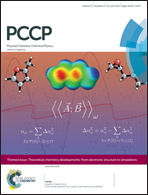A general transformation to canonical form for potentials in pairwise interatomic interactions
Abstract
A generalized formulation of explicit force-based transformations is introduced to investigate the concept of a canonical potential in both fundamental chemical and intermolecular bonding. Different classes of representative ground electronic state pairwise interatomic interactions are referenced to a chosen canonical potential illustrating application of such transformations. Specifically, accurately determined potentials of the diatomic molecules H2, H2+, HF, LiH, argon dimer, and one-dimensional dissociative coordinates in Ar–HBr, OC–HF, and OC–Cl2 are investigated throughout their bound potentials. Advantages of the current formulation for accurately evaluating equilibrium dissociation energies and a fundamentally different unified perspective on nature of intermolecular interactions will be emphasized. In particular, this canonical approach has significance to previous assertions that there is no very fundamental distinction between van der Waals bonding and covalent bonding or for that matter hydrogen and halogen bonds.


 Please wait while we load your content...
Please wait while we load your content...